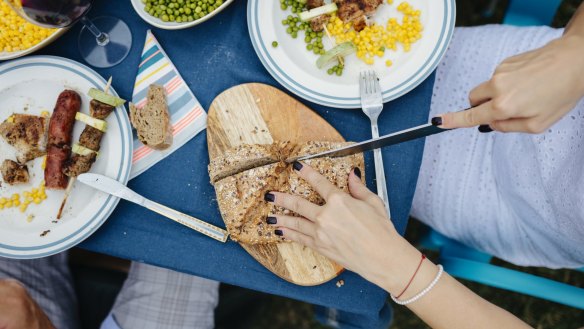Alfresco food safety: How to eat safely in the great outdoors

As the days and nights become warmer, enjoying our meals outside can be a chance to relax and make the most of the season.
Unlike eating on the run or in the company of digital devices, dining in the great outdoors puts food back at the centre of the eating experience.
Melbourne accredited practising dietician Jo Money says our eating habits have been hijacked by activities such as eating at our desks, while watching TV or scrolling on phones.
"[Eating in nature] helps break these patterns and ... naturally creates opportunities for more connected and mindful eating habits," Money says.
"When we eat outside our senses harmonise with nature and this helps us focus our attention on what we're eating.
Eating outdoors is a great way to make the most of Australia's great climate but warm weather increases the risk of food-borne bacteria.Lydia Buchtmann, Food Safety Information Council
"Plus we're more likely be in tune with what our body is telling us in response to foods – our likes, dislikes and satiety cues."
Eating outdoors also slows down mealtime and helps us savour every bite, Money says.
"It directly reduces stress and anxiety levels, a cause of digestive and irritable bowel symptoms."

A 2017 research review published in the journal Nature examined "mindful" eating and how it affects eating behaviours. The paper confirmed mindfulness-based approaches appear to address binge and emotional eating.
Another 2017 study by Ohio State University showed adults who don't flip on the TV during dinner are less likely to be obese.
Eating outdoors also offers obvious social benefits, whether it's a family meal on the veranda to a barbecue or picnic with friends.
But alfresco dining also brings risks, says Lydia Buchtmann, a spokeswoman of the Food Safety Information Council.
"Eating outdoors is a great way to make the most of Australia's great climate but warm weather increases the risk of food-borne bacteria," she says.
"Following safe handling measures guarantees you'll enjoy your outdoor barbecue or picnic germ free."
Here are some food safety tips to keep you safe throughout the warmer months.
Transporting and consuming foods
- The simple rule for food safety is to keep hot foods hot and cold foods cold, so pack cold and hot foods in separate containers when travelling.
- Don't pack food for a picnic if it's just been cooked and is still warm. Coolers cannot cool food fast enough to prevent bacteria from growing.
- It's best to cook, cool, cover and store pre-prepared food in the refrigerator overnight. Cooked chicken must be cold when put in the cooler.
- Keep your portable cooler at less than 5C by using freezer bricks, gel packs or plastic water bottles around the food to stop bacteria from growing. Using plastic water bottles will also ensure you have cold water to drink.
- Meat, poultry, dairy products and drinks must also be cold when put in the cooler.
- Place all foods in clean covered containers and avoid overpacking the cooler.
- Place the cooler in the coolest place in the car and cover it with blankets to keep the heat off. Keep the cooler in the shade at all times.
- If you're reheating make sure the food is steaming or bubbling before serving - more than 75C.
- Consume cold and raw foods within four to five hours.
- Consume cooked foods within two hours and discard after four hours as it has probably reached the temperature danger zone, which risks food poisoning.
Handling food
- To keep all surfaces and hands clean before cutting or serving food, pour white vinegar into a bucket of water and use to clean trays, plates and utensils - it's a great sanitiser and also kills bacteria.
- Carry disposable wipes or alcohol-based hand gel in case there's no water for hand washing.
- Don't put food directly on picnic tables as they're not always clean, so use clean plates or trays instead.
- To avoid cross-contamination, keep raw foods such as meat, poultry and fish separate from ready-to-eat foods such as salads, pasta and cold chicken to avoid juice spills.
- Cut meat into serving-size pieces before leaving home and have all salads ready to eat. This reduces the need to handle foods, particularly when there are no hand-washing facilities.
- Minimise the amount of time potentially hazardous foods - including dairy, eggs and cut fruit and vegetables - sit out on the table in high temperatures as this allows bacteria to grow. To be safe, serve foods in smaller containers and keep topping up.
- Cakes, scones, chips and nuts can stay out as they are less likely to allow bacteria to grow.
Cooking meat
- Cook burgers, sausages or poultry all the way through - until they are fully cooked, the juices run clear and there's no hint of pink in the middle. Use a meat thermometer to check they've reached 75C in the centre.
- Steaks and chops can be cooked to preference.
- It's OK to leave cooked meat to warm on a corner of the barbecue or covered on a plate for late arrivals. Just ensure it's protected from flies.
- Serve on a clean plate and use clean utensils.
Camping or trekking
- Once you open long-life milk you need to keep it cold. If you don't have a way to do this, pack condensed or powdered milk instead.
- Use long-life foods such as jerky, canned meats, baked beans, bread, chips, and biscuits.
- Hard cheese lasts for 24 hours without refrigeration but soft cheese must be kept cool.
- Use snap-lock bags to store food. They're also a great way to transport high energy foods such as dried fruit, nuts or chocolate bars while bushwalking.
- It also goes without saying - don't eat foods whose use-by-date has expired.
- Foods with a "best before" stamp can still be eaten after that date, but flavour and texture may be compromised.
The best recipes from Australia's leading chefs straight to your inbox.
Sign up